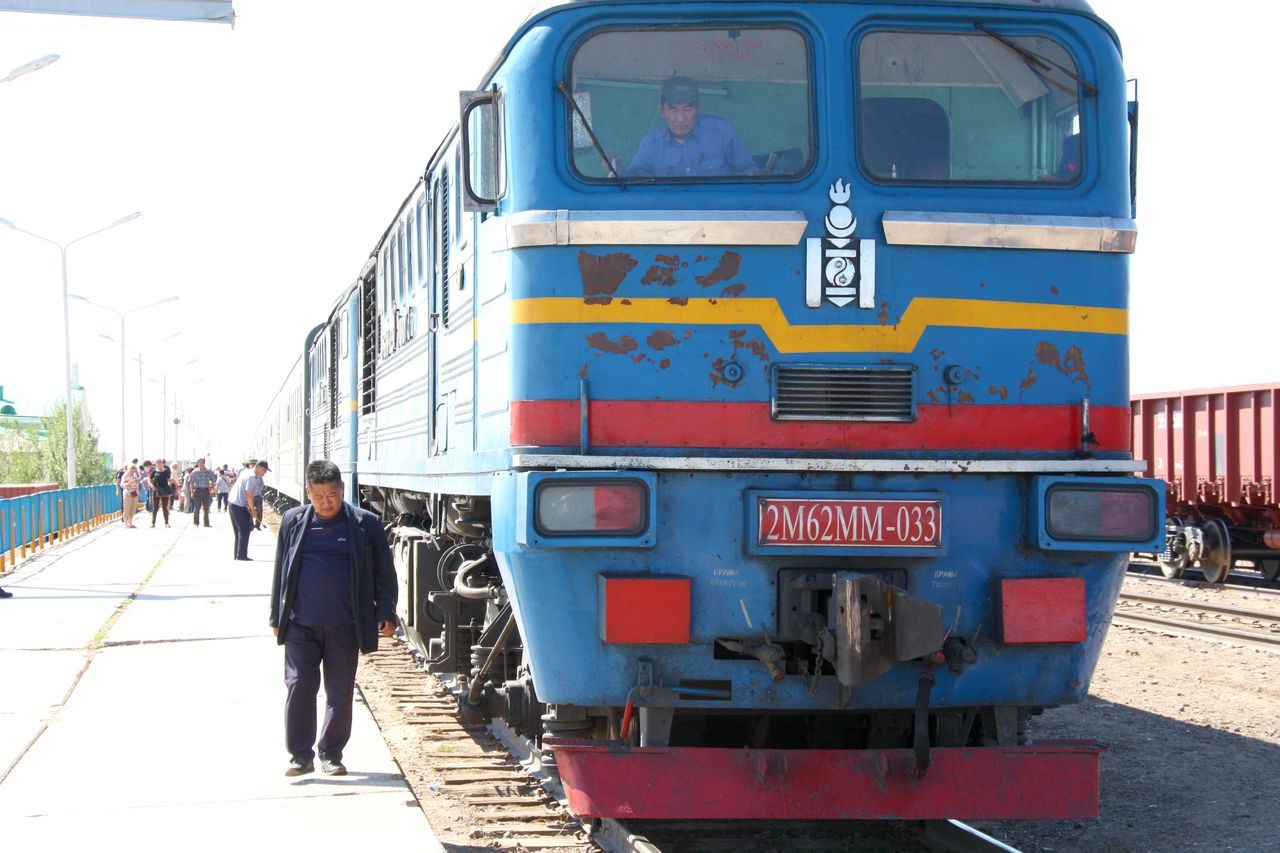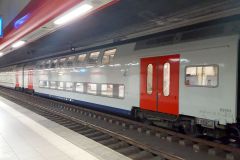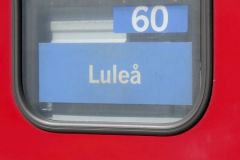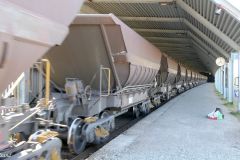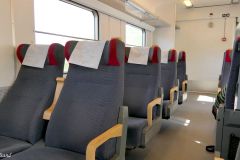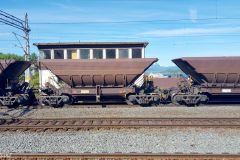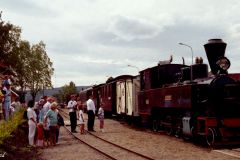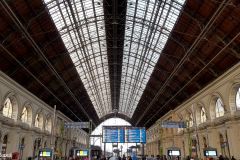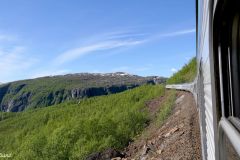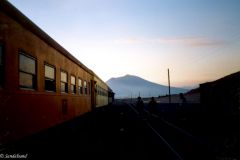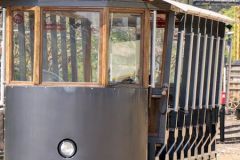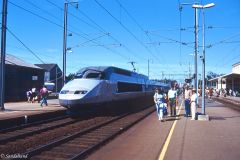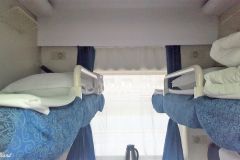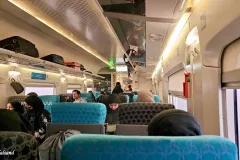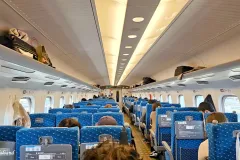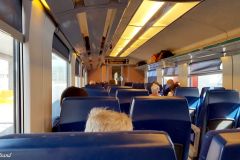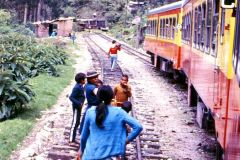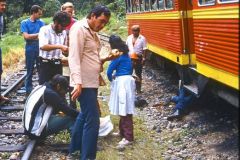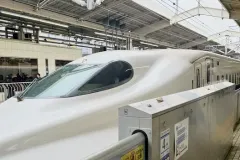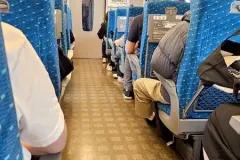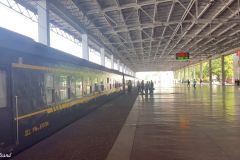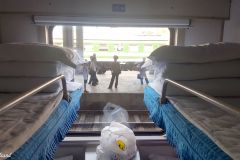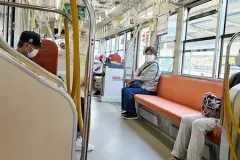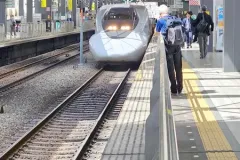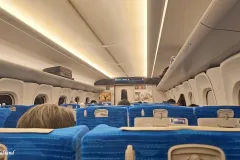This is an introduction to exciting train journeys. I have registered my travels on a world map and the distance travelled on trains has been calculated. It amounts to 29,799 km, corresponding to 74 % of the Earth around the equator.
Obviously, there must be some stories to tell. Some journeys are definitely more exciting than others, I admit. This article is a recount of five selected train journeys. The reasons for including them are explained later.
- Golmud to Xining (China)
- Cuzco to Machu Picchu (Peru)
- Nice to Rome (France, Italy)
- Flåmsbana (Norway)
- Trans-Siberian (Russia, Mongolia, China)
Let me add that these are all regular train journeys. There are a number of “special” trains, tracks and in general rail transportation solutions being explored in a separate article. The featured image above is of the Trans-Siberian train on a platform in Mongolia.
Golmud to Xining (China)
I am including this train journey because of Golmud’s status as a forbidden city and the stress involved in getting on board a Chinese train.
Golmud is a remote town in China’s western Qinghai region. We had in 1985 entered the region illegally from Tibet. Tibet itself had only recently opened up to foreigners travelling individually. The perhaps primary reason for Golmud’s status as forbidden territory was the fact that a number of China’s concentration camps were located here. This was the Gulag of China.
The following takes place after we had arrived on a 33 hours dusty bus-ride:
“We had to walk pretty far to the hotel and were stopped by the Public Security Bureau (PSB) on the way. They proved however utterly kind and charming, quite surprisingly considering Golmud’s status as a closed city. They politely commanded us to take the train on to Xining the following day.”
At the time we felt relieved not to receive a tougher welcome, but decided to continue the next day without stressing the Chinese politeness. Here is my continued story about the hardships of individual travelling in China at that time, fighting just to get at seat. I was travelling with two Danish girls and a guy from Switzerland.
.
“We took a morning train to Xining, straight to the east. There we arrived 27 hours later, quite exciting hours too. We had from the outset only hard-seats, for a Chinese price due to my student card. It was our wish to change to hard-sleepers on the train.
The girls went to buy while Philippe from Switzerland and me minded the luggage and the seats we had fought for. The case is that we had been pressed to run across the platform with a lot of Chinese, and climb through windows and doorways to get them. Before that we had played innocent Western tourists and sneaked in line to be the first out on the platform.
For some reason we received soft sleepers, something that annoyed us at first. Neel and Kirsten were so annoyed that they lost their temper and yelled at the conductor in Danish (!). (Maybe just as well, as nobody spoke English anyway.)
.
The soft sleepers are expensive, so I figured they wanted to keep the hard sleepers to themselves (the Chinese) and give the soft ones for tourists who evidently could afford such a luxury. I soon realised that we were not getting anywhere so I calmed down the girls and tried to make them concentrated on the positive aspects of our present condition.
And it surely was interesting to travel first class in China just once. We had the restaurant car to ourselves and with that came excellent meals for not much more than a dollar. (The train cost us 50Y each. 1 USD = 2.8 Yuan)”
Train travel in China is special for a number of reasons. The distances are long, the question of what class to travel, what kind of “sleepers” and so on are still valid today. Neither Golmud nor Xining were particularly interesting cities, the views out of the window are not remembered. This is in contrast to the next journey I am presenting.
Read the entry from this trip.
Cuzco to Machu Picchu (Peru)
I am including this train journey because of the exciting destinations, either way. Many would prefer to hike over the mountains on the Inca Trail(s). For various reasons we decided on the train, in 1987.
Getting a ticket was not easy, there was serious trouble on the railway line causing a long delay on the way back, but in retrospect it was a great way of arriving at the base of the legendary hilltop town of Machu Picchu. This is what I wrote in a letter home:
.
“Let me say a few words about our Machu Picchu trip and omit all the mess we were subjected to during the transportation to and from. First the train climbed slowly slalom up on the heights over Cuzco and then followed a big green valley where they grow huge maize cobs. The North Americans on the train had a good time.
We then drove into the Sacred Valley of the Incas where the Urubamba River threw itself wild and fast down to its final stop, in the Amazon itself. The railway track followed the river through the narrow valley with high, rugged mountains on either side until we arrived at our destination.
The ruins are on a ridge 900 metres straight up on a “Trollstigen” road from the station. A mighty sight and location. Machu Picchu proved to be well preserved and restored with terraces on both sides of the ridge. We walked on a small detour on the edge of a giant cliff to a bridge they had built along a vertical mountain face.”
Read the entry from this trip.

The train between Cuzco and Machu Picchu, Peru
Nice to Rome (France, Italy)
The InterRail deal in Europe used to be fantastic. In the beginning it offered all young people a way to travel for cheap on the continent on just about any train you liked. The deal has changed over the years but may still represent a very fine way of promoting international understanding.
As part of a month on rail throughout Western Europe, we had in 1991 spent a few days on the Côte d’Azur and were now heading for Rome, on the night train. This is what I wrote in my diary:
.
“Before leaving France we had bought a copy of the weekly newspaper The European. It had an article about the night train from Nice to Rome, focusing on the high crime rate on that particular train. Apparently thieves entered the train on the Italian side in the middle of the night, and in the middle of the tunnels, entered the compartments and stole whatever they found. The advice was to lock oneself in, stay there and open the door for nobody, not even for the train’s staff.
That was the very train we were taking. We allied with the other travellers and locked the door as thoroughly we could. In the middle of the night someone tried to get in, we don’t know who. Unfortunately we had not been able to get a sleeping car to Rome. It was a squeezed, hot, uncomfortable and sleepless night on a train that stopped on every station. We arrived safely and untouched in Rome on the minute, to our surprise.”
Read the entry from this trip.
Flåmsbana (Norway)
Some lines are more exciting to railway buffs and engineers than to the rest of us. True, there are some really great engineering achievements in the history of railways. For my part, I enjoy the ones that combine this with scenic views. The Flåm Railway (Flåmsbana) fulfils both criteria.
Being a Norwegian myself I had always heard of this spectacular journey and grabbed the opportunity on a visit to Bergen in 2003.
The technical stuff: According to the web page of the Flåm Railway it is “one of the world’s steepest railway lines on normal gauge tracks. Nearly 80 percent of the route is on a 55‰ gradient, ie: a rise of one meter per 18. The twisting tunnels that spiral in and out of the mountain are testament to the most daring and skillful engineering in the history of Norwegian railway.”
Great! What do they say about the scenery then?
.
“On the 20-kilometer train ride you will experience some of the most dramatic and magnificent Norwegian nature. Here you can see rivers that cut through deep ravines, waterfalls that plunge from the steep cliffs of the snow-capped mountain slopes, as well as mountain farms clinging on to steep slopes.”
I hereby make those fine words my own. Let me just add that the journey branches off from the main line between Oslo and Bergen. It takes about an hour and may well be combined with a boat trip on some of Norway’s most beautiful fjords to Bergen. The Flåmsbana is one of the most important tourist attractions in Norway.
I have not written about this trip in English, only in Norwegian.
One of the carriages of Flåmsbana
Trans-Siberian (Russia, Mongolia, China)
This is one of the legendary train journeys of the world, not least for the sheer length of it. We spent 4-5 days on the train from Moscow, then a couple of nights off in remote Mongolia, before continuing for another day and a half on train to Beijing.
This journey is presented extensively in a series of blog entries. Here is an excerpt from the round-up of the “restaurant” section.
.
“….Otherwise, we went to the restaurant. It was five to six carriages away from us. This was a Russian restaurant carriage, the other carriages were Mongolian. It is the rule on the Trans-Siberian railway that the country the train travels through provides the restaurant carriage. We therefore had a Russian restaurant carriage.
There we met the waitress Olga around fifty of age. She was missing three teeth in her upper jaw and had three gold teeth in her lower jaw. So she never smiled broadly, but was gentle and nice all the same. The restaurant was ruled by a lady boss, who did little. Her name was Tatiana, and she was grumpy in the morning. In the course of the day, and perhaps with some vodkas inside, she would wake up and speak a few words in Russian and a single word in English that did not always fit into the context. The local chef turned out to be named Sergei. He wore a red Kamikaze head band. Those were three good Russian names.
They had a very basic knowledge of the English language; in general they spoke only Russian to us. Very strange as they had this as a profession, and most guests were Western. Sometimes a lone, drunken Russian came around, but they were scarce. The Mongolians were not there in the restaurant, they were in the compartments with their noodle boxes.”
Read the entry from this trip.
The Russian restaurant car on the Trans-Siberian train
Read more
Are there train journeys in this world more exciting and even more spectacular than the ones mentioned here? Certainly, and I intend to seek them out. I love travelling by train.
I am still counting, but I have travelled by trains in 14 European countries (Norway, Sweden, Denmark, United Kingdom, Germany, Poland, Netherlands, Belgium, Czech Republic, Slovakia, Hungary, Austria, Switzerland, France, and Italy), 6 countries in Asia (Japan, Taiwan, China, Mongolia, Russia and Myanmar), 1 in Africa (Egypt), 1 in North America (Canada) and 3 in South America (Bolivia, Chile, and Peru). (Addition after this article was first published: North Korea)
Browsing this blog will give you insights into a number of these trips. Let me hint on three runner-ups to being included in the selection of train journeys:
- La Paz to Calama (Bolivia, Chile), through the world’s driest desert and past an amazing salt lake. Read.
- Mandalay to Nawngpeng (Myanmar), on a very slow train into the hills in lush vegetation, and across the fantastic 100m high, 100yrs old Gokteik steel viaduct. Read.
- Cairo to Aswan (Egypt), waking up on the night train to look outside the window on a bright new morning on the River Nile. The only thing better would be to sail this mighty river, and so we did later that day. Read.
And even more
Delving into this topic, Iron Wheels, I realised that trains are not just trains. There are a number of similar means of transportation. The carriages are different, the means of propulsion vary, and tracks vary as well. In short this gave an impetus to write a second part. It starts like this:
“Iron Wheels (2) Special rails: There are many varieties of rail transport; metro, cable car, cog track and tram to mention some. There are actually a lot more than you think of, and that is what I discovered drafting this article”.
Some pictures on this blog are tagged as train related: the interior and exterior of locomotives and cars, train stations or railway lines. I have not included views from trains. Here they are:

